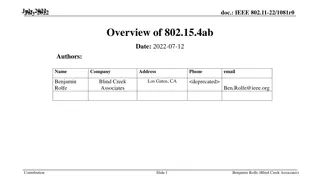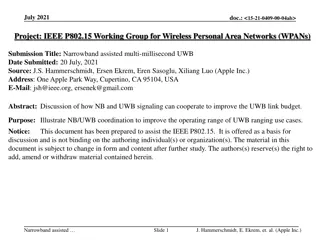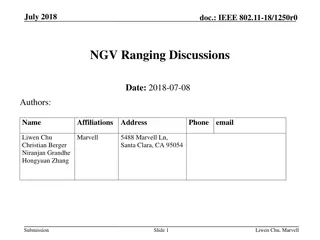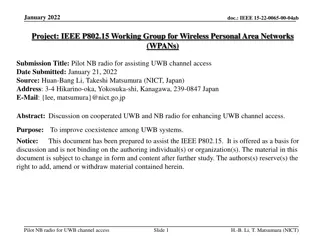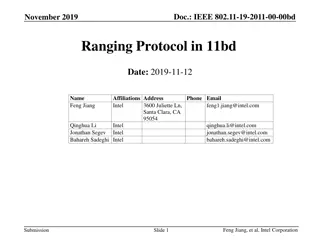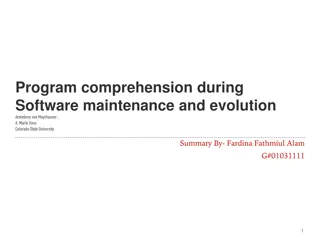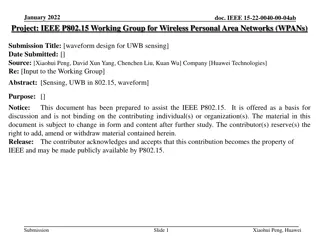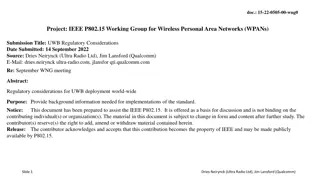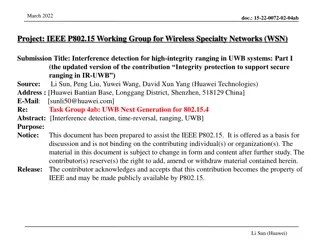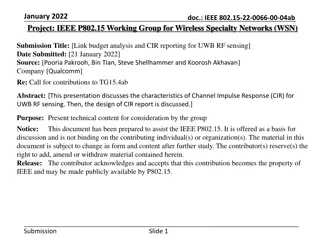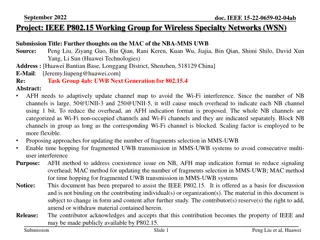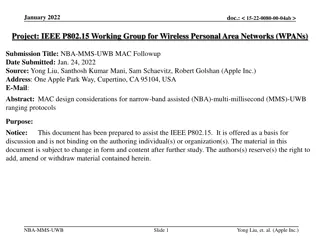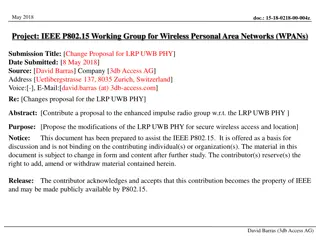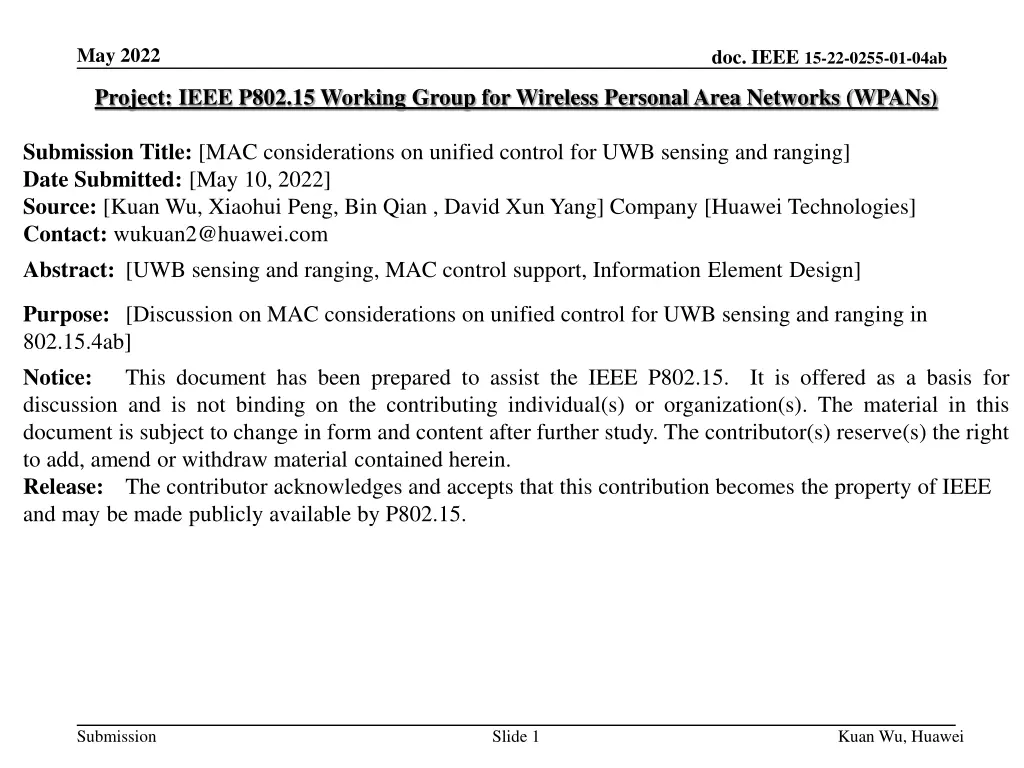
Unified MAC Control for UWB Sensing and Ranging in IEEE 802.15.4ab
Explore MAC considerations for unified control in UWB sensing and ranging within the IEEE 802.15.4ab standard. Discusses safeguards, interference mitigation, coexistence improvements, and more to enhance UWB capabilities. Related submissions and standards are also highlighted.
Download Presentation

Please find below an Image/Link to download the presentation.
The content on the website is provided AS IS for your information and personal use only. It may not be sold, licensed, or shared on other websites without obtaining consent from the author. If you encounter any issues during the download, it is possible that the publisher has removed the file from their server.
You are allowed to download the files provided on this website for personal or commercial use, subject to the condition that they are used lawfully. All files are the property of their respective owners.
The content on the website is provided AS IS for your information and personal use only. It may not be sold, licensed, or shared on other websites without obtaining consent from the author.
E N D
Presentation Transcript
May 2022 doc. IEEE 15-22-0255-01-04ab Project: IEEE P802.15 Working Group for Wireless Personal Area Networks (WPANs) Submission Title: [MAC considerations on unified control for UWB sensing and ranging] Date Submitted: [May 10, 2022] Source: [Kuan Wu, Xiaohui Peng, Bin Qian , David Xun Yang] Company [Huawei Technologies] Contact: wukuan2@huawei.com Abstract: [UWB sensing and ranging, MAC control support, Information Element Design] Purpose: [Discussion on MAC considerations on unified control for UWB sensing and ranging in 802.15.4ab] Notice: This document has been prepared to assist the IEEE P802.15. It is offered as a basis for discussion and is not binding on the contributing individual(s) or organization(s). The material in this document is subject to change in form and content after further study. The contributor(s) reserve(s) the right to add, amend or withdraw material contained herein. Release: The contributor acknowledges and accepts that this contribution becomes the property of IEEE and may be made publicly available by P802.15. Submission Slide 1 Kuan Wu, Huawei
May 2022 doc. IEEE 15-22-0255-01-04ab PAR Objective Proposed Solution (how addressed) Safeguards so that the high throughput data use cases will not cause significant disruption to low duty-cycle ranging use cases Interference mitigation techniques to support higher density and higher traffic use cases Other coexistence improvement Backward compatibility with enhanced ranging capable devices (ERDEVs) Improved link budget and/or reduced air-time A unified MAC control support for sensing systems piggy- backing on ranging protocols Additional channels and operating frequencies Improvements to accuracy / precision / reliability and interoperability for high-integrity ranging Reduced complexity and power consumption Hybrid operation with narrowband signaling to assist UWB Enhanced native discovery and connection setup mechanisms Sensing capabilities to support presence detection and environment mapping Low-power low-latency streaming MAC control support for UWB sensing session control and configuration Higher data-rate streaming allowing at least 50 Mbit/s of throughput Support for peer-to-peer, peer-to-multi-peer, and station-to- infrastructure protocols Infrastructure synchronization mechanisms Submission Slide 2 Kuan Wu, Huawei
May 2022 doc. IEEE 15-22-0255-01-04ab Related submission 1. IEEE Standard for Low-Rate Wireless Networks Amendment 1: Enhanced Ultra Wideband (UWB) Physical Layers (PHYs) and Associated Ranging Techniques, IEEE Standard 802.15.4z-2020 (Amendment to IEEE Standard 802.15.4-2020), IEEE SA, pp. 1 174, Aug. 25, 2020 15-21-0530-00-04ab-dl-tdoa-positioning-tdma-scheme (Oct. 2021) , Jean-Marie Andr et al. 15-21-0616-01-04ab-beacon-and-ranging-frames-to-support-downlink-tdoa-dl-tdoa-location- service-in-802-15 (Nov. 2021), Yongsen Ma et al. 15-22-0040-04-04ab-waveform-design-for-uwb-sensing (Jan. 2022) , Xiaohui Peng et al. 15-22-0155-00-04ab-cir-feedback-scheme-for-uwb-sensing (Mar. 2022) , Bin Qian et al. 15-22-0175-00-04ab-sensing-device (Mar. 2022) , Dag T. Wisland et al. 15-22-0012-02-04ab-uwb-sensing-scenarios-for-802-15-4ab (Jan. 2022) , Pooria Pakrooh et al. 15-21-0399-00-04ab-uwb-sensing-in-802-15 (Jul. 2021) , Frank Leong et al. 15-22-0061-00-04ab-sensing-continued (Jan. 2022) , Frank Leong et al. 10. 15-22-0083-01-04ab-uwb-sensing-concepts (Jan. 2022) , Dag T. Wisland et al. 2. 3. 4. 5. 6. 7. 8. 9. Submission Slide 3 Kuan Wu, Huawei
May 2022 doc. IEEE 15-22-0255-01-04ab Introduction In this contribution, we provided a preliminary study on a unified MAC control for sensing and ranging Advanced Ranging Control IE (ARC IE) [1] is reused to extend the round usage definitions A newly designed sensing device management IE (SDM IE) derived from ranging device management IE (RDM IE) [1] is introduced Submission Slide 4 Kuan Wu, Huawei
May 2022 doc. IEEE 15-22-0255-01-04ab Recap of DL-TDOA Anchor Anchor OWR TWR Anchor Tag Ranging packet One-way ranging (OWR) between anchors and tags is used for DL-TDOA services [1]-[3] In the DL-TDOA scenarios, inter-anchors can act in a two-way ranging (TWR) manner [3] Remark: TWR services between anchors can piggy-back on OWR/DL-TDOA services, or vice versa. Submission Slide 5 Kuan Wu, Huawei
May 2022 doc. IEEE 15-22-0255-01-04ab Recap of UWB sensing pulse shape A preliminary study is proposed on sensing waveform design and requirements considerations [4] An example sensing pulse shape is the 8th order Butterworth pulse multiplied by Gaussian window [4], with low post-ring (left figure above), meanwhile complying with the power spectral density (PSD) mask (right figure above) Remark: A well-designed unified pulse shape may have the potentials to perform simultaneous sensing and ranging. Submission Slide 6 Kuan Wu, Huawei
May 2022 doc. IEEE 15-22-0255-01-04ab Recap of UWB sensing session Sensing block Sensing Round 0 Sensing Round 1 Sensing Round 2 Sensing Round 3 Sensing Round N-1 Sensing Slot 0 Sensing Slot 1 Sensing Slot 2 Sensing Slot 3 Sensing Slot M-1 Sensing round ... Sensing Slot Sensing Slot Sensing Control phase Sensing phase Measurement report phase Legacy 4z round/block structure is employed for UWB sensing session [5] Sensing shares a similar round timing structure with ranging in terms of a control phase, a measurement phase and a reporting phase [5] Deriving sensing system from ranging protocol is suggested in [6] Remark: A unified MAC control signaling can be considered for sensing and ranging. Submission Slide 7 Kuan Wu, Huawei
May 2022 doc. IEEE 15-22-0255-01-04ab Observation and Motivation Controller/Requesting device Sensing/Ranging device Sensing/Ranging device OWR Tag Sensing TWR Object Sensing/Ranging device Control/Request Sensing/Ranging packet Measurement related report Sensing/Ranging device FIG 1. A generalized/unified UWB role structure Regardless of sensing/ranging [1-10], all these services can be depicted by a generalized/unified UWB role structure model In this contribution, we propose a unified MAC control support for sensing and ranging. Specifically, round usage definition and device role management are studied via ARC IE and RDM IE, respectively Submission Slide 8 Kuan Wu, Huawei
May 2022 doc. IEEE 15-22-0255-01-04ab Re-using ARC IE for extended round usage definition Bits: 0 1 2 3 4-7 RBDP RRDP RSDP SIP Reserved Figure 7-106d Content Control field of the ARC IE Ranging Round Usage field in ARC IE in 802.15.4z [1] only configurates ranging services Utilizing some of the reserved bits in Content Control field to extend round usage to include sensing services and various services piggy-backing In many-to-many scenarios, legacy devices can still recognize its round usage via ARC IE Submission Slide 9 Kuan Wu, Huawei
May 2022 Re-using ARC IE for extended round usage definition (cont.) doc. IEEE 15-22-0255-01-04ab An example list of extended round usage definitions Extended round usage value Extended round usage definition Remark 0 One-way ranging (OWR) Legacy round usage definitions in ARC IE 1 Single-sided two-way ranging (SS-TWR) 2 Double-sided two-way ranging (DS-TWR) 3 SS-TWR piggybacking OWR Newly introduced round usage definitions in ARC IE 4 DS-TWR piggybacking OWR 5 One-way sensing (OWS) 6 Two-way sensing (TWS) 7 OWS piggybacking OWR 8 TWS piggybacking SS-TWR 9 TWS piggybacking DS-TWR 10 TWS piggybacking SS-TWR and OWR 11 TWS piggybacking DS-TWR and OWR Submission Slide 10 Kuan Wu, Huawei
May 2022 doc. IEEE 15-22-0255-01-04ab Thoughts on sensing device management Since sensing and ranging share many similarities in slotted round structure [5], the sensing device management IE (SDM IE) can be derived from RDM IE Apart from the functions already supported by RDM IE, the SDM IE should at least add the following functions as: - Sensing mode indication: active sensing or passive sensing [7] - Device role determination according to the sensing mode and extended round usage on services piggy-backing modes specified by ARC IE Submission Slide 11 Kuan Wu, Huawei
May 2022 doc. IEEE 15-22-0255-01-04ab Thoughts on sensing device management design (cont.) Example format of SDM IE content field format Bits: 0 1 2-7 Octets: variable SIU Address Size SDM List Length SDM List Bits: 0 1 2-8 9-15 Octets: 2/8 Sensing Role Sensing Mode Sensing Slot Index Reserved Address Sensing Mode=0 Sensing Mode=1 Sensing Role=0 Passive sensing, the selected device is the sensing transmitter In case of simultaneous sensing and ranging, the selected device is also the ranging responder Active sensing, the selected device is the receiver In case of simultaneous sensing and ranging, the selected device is also the ranging responder Sensing Role=1 Passive sensing, the selected device is the receiver In case of simultaneous sensing and ranging, the selected device is also the ranging initiator Active sensing, the selected device is the transmitter In case of simultaneous sensing and ranging, the selected device is also the ranging initiator Simultaneous sensing and ranging refers to round usages provided in the aforementioned list of extended round usage definitions Submission Slide 12 Kuan Wu, Huawei
March 2022 doc. IEEE 15-22-0255-01-04ab Summary and suggestions In this contribution, we proposed a preliminary study on unified MAC control support for sensing and ranging The ARC IE can be reused to configurate the extended round usage, providing some backward compatibility with legacy ranging devices The SDM IE can be derived from RDM IE to support sensing device management More design considerations on unified MAC for sensing and ranging should be further discussed Submission Slide 13 Kuan Wu, Huawei
May 2022 doc. IEEE 15-22-0255-01-04ab Appendix Passive sensing [6]: Initiator is the sensing receiver, responders are sensing transmitters Active sensing [6]: Initiator is the sensing transmitter, responders are sensing receivers Responder/Rx Initiator/Tx Responder/Tx Initiator/Rx Object Object Passive sensing Active sensing Sensing request Sensing packet Sensing measurement related reports Submission Slide 14 Kuan Wu, Huawei
May 2022 doc. IEEE 15-22-0255-01-04ab Appendix Illustration of OWS and TWS proposed in [7] Responder/Rx Initiator/Tx Responder/Tx Initiator/Rx Object Object Two-way Sensing (TWS) One-way Sensing (OWS) Sensing packet 1 Sensing packet 2 Submission Slide 15 Kuan Wu, Huawei


